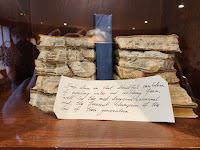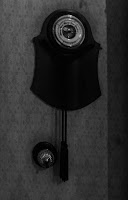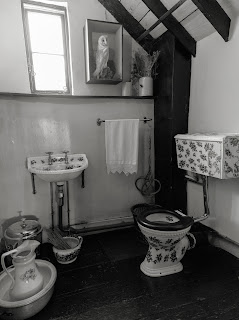Take the Circle and Hammersmith/City tube line at Westbourne Park Station and eight minutes later you arrive at the Baker Street Station.
For those of you not sure where you've heard the name Baker Street, let me remind you of this infamous character....
Yes! That's Sherlock! Sherlock Holmes, the infamous detective and the figment of Sir Arthur Conan Doyle's imagination.
Photo courtesy of arthur-conan-doyle.com
"Just like Dr. Watson, Sir Arthur Doyle studied and practised medicine. Doyle was the doctor on the Greenland whaler Hope of Peterhead in 1880 for seven months. Later he tried to set up a practice with a friend. However, that didn't work out and he set up an independent practice. However, patients were scarce, and the young doctor often found himself with ample free time. During these quiet hours, Doyle began writing short stories, using his vivid imagination to create intricate plots and memorable characters. His early literary endeavors, though not immediately successful, provided a much-needed escape from the tedium and financial strain of his fledgling medical practice. He created the character Sherlock Holmes in 1887 for A Study in Scarlet, the first of four novels and fifty-six short stories about Holmes and Dr. Watson. "
"Holmes was partially modeled on Doyle's former university teacher and friend Joseph Bell. Bell’s keen powers of observation, his ability to deduce details about his patients’ lives and ailments from seemingly trivial observations became the hallmark of Doyle’s famous detective.
Doyle’s creation of Sherlock Holmes captivated readers and influenced public opinion and societal norms. The character’s emphasis on logic, observation, and scientific methods resonated with a society on the cusp of modernity. Holmes’s adventures popularized forensic science, with many crediting Doyle’s stories for inspiring advancements in criminal investigation techniques. The character’s impact extended beyond literature, contributing to the evolution of detective work and the public’s understanding of crime-solving.
Doyle's attitude towards his most famous creation was ambivalent. In November 1891, he wrote to his mother: "I think of slaying Holmes, ... and winding him up for good and all. He takes my mind from better things." His mother responded, "You won't! You can't! You mustn't!" In an attempt to deflect publishers' demands for more Holmes stories, he raised his price to a level intended to discourage them, but found they were willing to pay even the large sums he asked. As a result, he became one of the best-paid authors of his time.
Eventually, in 1893 Dole decided to kill Sherlock at the end of the 26th story, The Adventure of the Final Problem. However, 8 years later, under family and editor pressure, he "resurrected" the detective and wrote 34 more stories between 1901 and 1927."
In order to Memorialize this ficticious character and to commomerator Sir Arthur Doyle's contribution to society, in 1990 The Sherlock Holmes Museum opened its iconic front door to the public.
This first of its kind museum (first in the sense that it is dedicated to a ficticious character) is situated in Baker Street bearing the number 221B, although it lies between numbers 237 and 241. This Georgian townhouse was formerly used as a boarding house from 1860 to 1936.
The interior of the house covers the period of 1881 to 1904 when the stories describe Sherlock Holmes and Doctor Watson residing there as tenants of Mrs. Hudson. The museum features exhibits items from several different adaptations of Sherlock Holmes, and recreations of scenes from the 1984 Granada Television series Sherlock Holmes.
The small and intimate setting of 221B is filled with authentic Victorian furniture and curiosities, and a treasure trove of items belonging to Sherlock, his friends and adversaries. Sadly, the lighting within this four story building was not conducive to clicking with a "real" camera 😉, hence I used both my Z as well as my cell to capture items of interest.
The house is really small and they let small groups in to the 1st Floor to meet the Guide who talks about the history of Sherlock. You are then free to go up to the 2nd and 3rd floors at your own pace.
Two items were of most interest to me in this museum. The first being the Sherlock Holmes busts...
The museum commissioned Champion 3D (a design and printing 3d company) to create seven busts of actors who portrayed Sherlock Holmes over the past 100 years in film and TV. Each bust needed to accurately capture the actors’ appearances as they were in their respective Sherlock Holmes roles. To ensure stylistic consistency, all busts were to be sculpted by the same 3D artist.
The list of the actors which were sculpted and the years they portrayed Sherlock Holmes were.....
- William Gillette (1899-1930)
- Basil Rathbone (1939-1946)
- Peter Cushing (1959-1968)
- Jeremy Brett (1984-1994)
- Robert Downey Jr. (2009-2011)
- Ian McKellen (2015)
- Benedict Cumberbatch (2010-2017)
..........this room
Obviously, a fair amount of work has gone into setting it up, furnishing the rooms in a Victorian style with various objects which could be said to have an association with the Sherlock Holmes stories.The guides, doorman and shop assistants are all in Victorian dress, but in all honesty it is not a must see museum when visiting London.
(source) (source)(source)(source)(source)




































































An interesting diversion I guess Camellia but probably your review and photographic report negates the need to go in person then. Thanks for sharing.
ReplyDeletePeter, definitely a tourist attraction and money maker but when time is not of the essence, worth a visit.
Delete